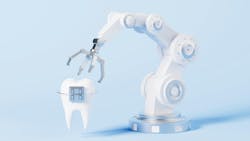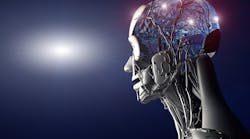Artificial intelligence: A new era for dental hygiene
Listen to the article on our podcast!
Between Alexa, Siri, Google, ChatGPT, and even our vehicles' cruise control, we interact with artificial intelligence (AI) in our everyday lives. In the field of dentistry, AI has offered innovative solutions that improve patient care, workflow efficiency, and make dental services more accessible. From early diagnostic tools to advanced learning algorithms, AI is reshaping how dental providers approach their care for patients. It can also optimize clinical tasks, streamline processes, and provide more personalized care for patients. Overall, AI is becoming an essential component in modern dentistry that enhances both the patient and provider experience.
History of AI in dentistry
Although the concept of artificial intelligence began around 1950, AI made an initial impact on dentistry in the 1990s. Back then, early stages of computer-aided models (CAM) were able to render 3D models of crowns just by analyzing a person's remaining teeth. Digital imaging became accessible in 2007, allowing computers to read dental radiographs. Now, we can utilize AI as support for identifying conditions, incorporating telehealth, providing personalized care, and for patient interactions. It is also capable of predictive analytics to enhance a patient's treatment plan.
Types of dental AI
AI in dentistry encompasses several kinds of technologies, each with unique capabilities:
-
Machine learning (ML) and deep learning (DL): These algorithms analyze substantial data to recognize patterns and assist in clinical decision-making. Such algorithms can help accurately identify dental conditions such as caries, periodontal disease, and other abnormalities.
-
Natural language processing (NLP): NLP allows computers to understand and process human language, making it valuable for automating documentation, periodontal charting, and virtual patient interactions.
-
Computer vision: This technology is significant in interpreting visual data, particularly radiographs, along with intraoral scans.
Robotic process automation (RPA): RPA focuses on automating repetitive administrative tasks such as billing, appointment scheduling, and insurance claims processing, freeing up dental staff to focus more on patient care.
Enhancing dental hygiene workflow
AI technologies can transform workflow in dental hygiene practices by streamlining and automating various tasks, allowing more time for hands-on care. For instance, AI-powered voice recognition and NLP tools can assist in periodontal charting. This reduces the burden on dental hygienists of struggling to chart alone or pulling their fellow team members from their own
workload. AI algorithms also enhance diagnostic accuracy by analyzing digital images and radiographs, enabling dental hygienists to identify dental conditions more efficiently and accurately, thus better educating their patients.
AI can also predict equipment failures through continuous monitoring and schedule necessary maintenance in advance, minimizing downtime and ensuring smooth clinical operations. By optimizing patient flow, AI can predict the duration of visits and manage appointments more efficiently, reducing waiting times and enhancing overall organization within dental practices.
Improving accessibility
AI has immense potential to enhance accessibility to dental care, especially for underserved populations. AI-powered teledentistry platforms can greatly benefit dental hygienists working in nontraditional settings by enabling remote consultations and preliminary diagnoses. AI can also create personalized educational content that can easily accommodate diverse literacy levels and even surpass language barriers. Such advancements in AI are helping to redefine the scope and reach of dental hygiene practice, making high-quality care more accessible and inclusive.
Limitations and concerns
Despite its noteworthy benefits, AI doesn't come without reservations. Some clinicians worry that overreliance on AI could undermine their judgment, particularly in complex cases where AI may be less accurate than experienced professionals. Additionally, the cost of implementing and maintaining AI in dental practices is a concern. Either way, AI is changing health care. Viewing AI as a tool rather than a replacement for clinical judgment can help dental professionals make more informed decisions. With the right training and guidelines in place, the transition can lead to greater precision, efficiency, and patient satisfaction. The focus should be on embracing AI's capabilities to support human expertise, ensuring that technology elevates the quality of care without overshadowing the essential human element.
Dental professionals should stay informed about AI advancements, contributing to the ongoing improvement of AI in dental practice integrations. As the industry continues to develop standards and best practices, AI can play a pivotal role in advancing our field, ultimately leading to better outcomes and more accessible care for all patients.
Editor's note: This article originally appeared in the November/December print edition of RDH Magazine.
References
-
Agrawal P, Nikhade P. Artificial intelligence in dentistry: Past, present, and future. Cureus. 2022;14(7):e27405. doi: 10.7759/cureus.27405
-
Batra P, Tagra H, Katyal S. Artificial intelligence in teledentistry. Discoveries (Craiova). 2022;10(3):153. doi: 10.15190/d.2022.12
-
Umer F, Adnan S, Lal A. Research and application of artificial intelligence in dentistry from lower-middle income countries - a scoping review. BMC Oral Health. 2024;24(1):220. doi: 10.1186/s12903-024-03970-y
-
What is (AI) artificial intelligence? University of Illinois Chicago. Modified May 2024. https://meng.uic.edu/news-stories/ai-artificial-intelligence-what-is-the-definition-of-ai-and-how-does-ai-work/
About the Author

Kevin Ohashi Lopez, MHA, BSDH, RDH
Kevin Ohashi Lopez, MHA, BSDH, RDH, is a San Francisco-based dental hygienist. He graduated from West Coast University in 2019 and obtained a master's in health administration. Currently practicing in Napa Valley, Kevin brings diverse dental experience, with both front- and back-office expertise. He is a speaker, ambassador, mentor, Guided Biofilm Therapy trainer with the Swiss Dental Academy, and NBDHE review faculty with Sanders Board Preparatory. Connect with him on Instagram @kevstalksteeth or via email at [email protected].

